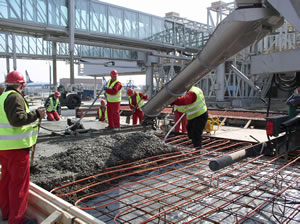Aug 13 2007
In Poland, as part of the development and modernisation of Warsaw Frederic Chopin Airport, Raychem electric under-surface ramp heating systems have been installed to stop ice or snow causing operational disruption on aircraft aprons and vehicle ramps around Terminal 2.
Manufactured by Tyco Thermal Controls, these heating systems will operate automatically to keep important areas used by pedestrians, vehicles or aircraft open, usable and safe in freezing conditions, without a need to commit manpower to the task.

Raychem ramp-heating systems feature robust heating cables, for embedding in concrete or sand, which power up as soon as surface sensors detect a combination of both low ambient temperature (eg. 3°C variable set point) and moisture. In these conditions the heating cable activates to maintain the surface temperature above freezing until ambient temperatures rise again – a significantly more efficient and reliable method than spreading sand or salt or manually removing snow and one which will not damage the surface.
The aircraft apron and the vehicular ramp at Warsaw Frederic Chopin Airport are of different constructions so two different Raychem heating system solutions were employed. For the concrete aircraft apron, the system has self-regulating trace heating cable with 90W/m output mounted on mesh and embedded within the concrete. The surface of the exposed vehicular ramp at Terminal 2 in contrast had a hot-cast asphalt surface and would be subjected to the application of a 30 ton roller. These installation conditions meant that the heating cable had to be able to offer resistance to temperatures circa 250°C and have very high mechanical strength. Accordingly, the Raychem ramp heating system for this area features mineral insulated (MI) heating cable, being the only cable type suitable for these conditions.
For control of heating system regulators, Raychem VIA-DU-20 controllers with temperature and ground moisture sensors have been employed to ensure the system only activates when conditions indicate the potential for ice or snow. Accurate control of activation and the amount of heat applied are the key factors making electric ramp heating economically viable for such large areas.